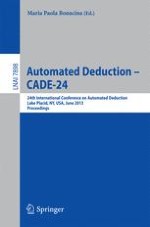2013 | Buch
Automated Deduction – CADE-24
24th International Conference on Automated Deduction, Lake Placid, NY, USA, June 9-14, 2013. Proceedings
herausgegeben von: Maria Paola Bonacina
Verlag: Springer Berlin Heidelberg
Buchreihe : Lecture Notes in Computer Science
